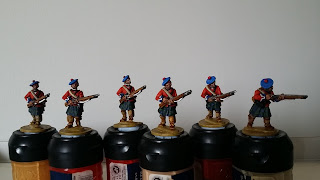Following on from some more games of Muskets and Tomahawks, a friend bought a British 'army' pack from North Star. Nice figures and I asked if I could paint the highlanders for him, as I like painting uniforms and the Black Watch are my local regiment.
I thought at first I would try a contrast paint on the jackets. It was OK, but not the effect I was looking for, so I decided to go with normal acrylics.
Kilts, bonnets and facings. And, yes, I know the Black Watch initially had buff facings and did not receive 'Royal' status till after Ticonderoga, but I just thought I want blue facings.
Now, in here, I will say that one thing that annoys me about figure sculptors and manufacturers is that they do not seem to understand the way the folds of a kilt work, or exist, or look. This is not just these figures, but many manufacturers who make highlanders for all periods. Sculptors don't seem to do any research and as a result they seem to think a kilt is like the lower part of a Roman or Greek tunic. Bah humbug!
The back of a kilt has pleats which should appear like many, many sharp creased folds. As these figures did not have this I decided I'd have to paint them on. A bit of a nuisance but I wanted the effect.
Painting kilts is not that difficult. Here's a technique I learned from a painter of bigger figures (54/75/90mm) over 40 years ago.
1. Paint the kilt blue.
2. Paint the green vertical and horizontal strips. Have a careful look at the way the strips appear, so horizontal blue at the hem, green, blue, green, and blue. This is deliberate so that the central front of the kilt is a blue square.
3. Outline the green strips with a thin coat / semi-wash of black so that they appear a very dark green lines.
4. Stop at this point if you want. It's usually good enough for smaller figures. For larger figures you can add a thin line of black mid-strip.
5. Step back and look from 2 or 3 foot away. If it's good enough, then stop.
Here, things are shaping up with the facings, kilts and bonnets looking better.
It was a lot of fun painting these. I must do more.
And, almost inevitably, on the highlander's first action on the table top, their side lost. I think it's an unwritten law of the wargaming universe, that newly painted figures will lose their first battle on the tabletop.













18th Century small kilts may not have had the early 19th Century/Victorian pleats in the back. They were made from full Plaids in this period for ease of movement and wearing.
ReplyDeleteThanks, Simon.
DeleteApologies, I should have been more clear in my post, and included contemporary prints of highlanders in the full plaids. I accept the 18c kilts were cut-down and not the more modern version.
However, my central contention is still than sculptors do not put enough folds into plaids/kilts. If you look at the third rear-view picture above, I think many of those kilt sculpts are far too smooth.
cheers,
Tom
You have done a great job on these figures!
ReplyDeleteThanks, Alan. They were fun to paint, and we did laugh when their their side lost in their first game.
Delete